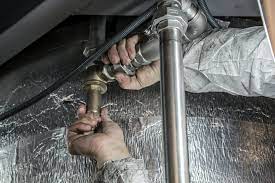Plumbing is a system of pipes within a building that distributes and removes waterborne wastes. It is normally distinguished from the water and sewage systems that serve an entire city or group of buildings. Plumbing professionals work to maintain a building’s pipes and other plumbing-related equipment. A well-functioning plumbing system also helps reduce water costs and prevents rot, mold, and other problems. Here are the benefits of plumbing. Here’s why plumbing is so important for modern society.
There are three main types of plumbing. The most basic type is known as a single stack system, which is based on the premise that drain lines can support three constituents: soil, wastewater, and ventilation. The plumbing devices attached to this system all require deep-seal traps that are 75mm water-tight. These systems are often found in basements or crawl spaces. If you’re remodeling an entire home, you’ll want to choose a plumbing professional who has experience with this system.
If you don’t have a plumber, you can try to fix a slow-flowing drain with drain cleaner. However, if you’re not sure how to fix a plumbing vent, you should call a plumber for help. You might think it’s fixed, but you’re only fooling yourself. Plumbing problems can be quite complicated, so it’s important to choose the best plumber for the job. However, plumbing is essential for any home.
The best plumbing service provider will have the proper training and experience to provide high-quality plumbing services to their customers. The best plumbers will have a good knowledge of plumbing regulations and know how to identify the cause of a blockage. If you suspect a blockage, your plumber will use a camera to inspect your plumbing system and find the source of the blockage. Then, he or she will be able to repair the problem and resolve it once and for all.
The first step in new construction plumbing is known as the plumbing rough-in. This process requires expert installation and careful planning. It connects the construction with the waste and supply systems. Taking time to plan ahead for plumbing rough-in will prevent problems later on. Rough-in is the stage when supply lines enter the building, and the plumbing rough-in occurs before the slab foundations are completed. The plumbing rough-in process can be costly and time-consuming, but the planning and execution will help reduce the chances of later plumbing problems.
There are many types of pipes for plumbing, and each type has its pros and cons. Copper pipe, for example, is the best choice for a residential system because it is corrosion-resistant and can last up to 50 years. Copper pipes are generally considered the best choice to protect water quality and are the most common in residential and commercial applications. They also do not warp or rust easily. A good plumber should be able to help you choose a pipe that works for you.
PEX pipes are an excellent choice for water supply plumbing. They can be woven easily through walls while remaining durable enough to withstand high pressure. PEX pipe is also color-coded for hot and cold water, so it’s easy to see which one is right for your home. PEX pipe, on the other hand, is a more affordable plastic tube. PEX pipes also don’t leach chemicals into the water, which is another reason why they’re the best choice for repiping or new construction.

